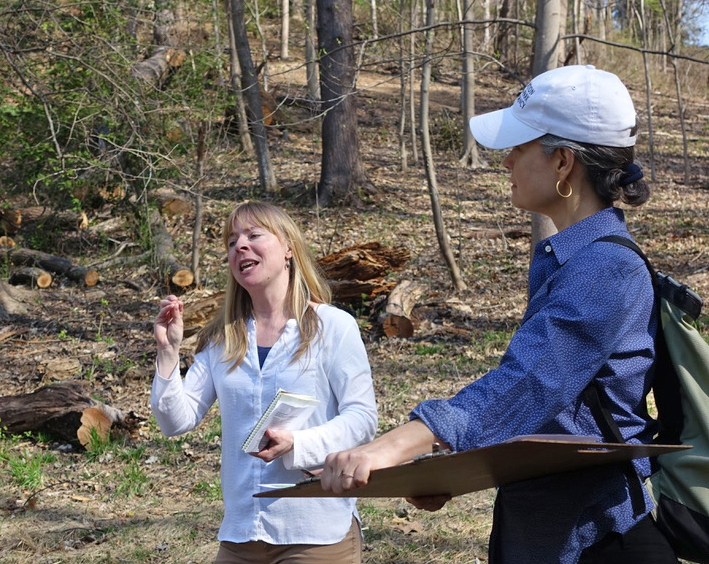Dumbarton Oaks Park Conservancy & GW's Sustainable Landscapes Program recently sponsored an exciting two-day event featuring a lecture and hands-on tour of Dumbarton Oaks Park with nationally-known expert in ecological planting design, Claudia West, and landscape architect Liza Gilbert.
Participants learned about how to give urban planting the spirit, beauty and resiliency of more natural landscapes, using the Urban Woodland Garden designed by Beatrix Farrand as a shining example of great urban planting. During the hands-on tour of the Park participants discussed the revitalization efforts with the leaders, while engaging in field-based master planning.
Claudia West delivered an engaging talk, “The Power of Urban Nature: How Great Urban Planting Enriches Lives” at GW on April 13 that asked participants to think about leftover urban spaces that they see everywhere. These spaces are usually small and abandoned, but are often overrun with a very rich assortment of weeds, in contrast to typical 'planted' urban spaces that offer nothing more than poor grass and sparse trees.
Claudia's thesis, along with her business partner and co-author Thomas Rainer (adjunct professor at CPS), is that we can learn from the lush vegetation in these tight urban spaces how to introduce healthy, richly planted landscapes to our urban communities, resulting in healthy air, happier communities and storm water conservation.
Their book, Planting in a Post-Wild World, expands on this thesis with both theoretical botanical science and practical lessons on how to abstract the essence of native plant communities to enliven the urban fabric of our cities. She gave examples of using adapted plant species in combinations to colonize tough urban sites.
Claudia West (right, seated), signs copies of her book “Planting in a Post-Wild World” following her lecture at GW on April 13 (Photo courtesy of Adele Askar).
On a beautiful Saturday morning, April 14, Claudia West and Liza Gilbert conducted a workshop in Dumbarton Oaks Park, Washington, D.C. Participant groups were asked to observe specific natural spaces in the park and make suggestions for further conservation measures that would preserve the aesthetic of Beatrix Farrand's original designs while conserving and enhancing the existing native plant communities. For example, they tagged for potential removal small trees of invasive species that have crowded into spaces that were originally designed as meadow views reaching into the forest.
"This exercise, coming on the heels of Claudia's inspiring talk, was a terrific combination of design thinking and hands-on participation in the conservation and restoration efforts in Dumbarton Oaks Park,” said Adele Askar, FASLA, associate dean for academic excellence and associate professor of landscape design, GW College of Professional Studies. “Our GW Landscape Design community was very fortunate to be a part of it.”



